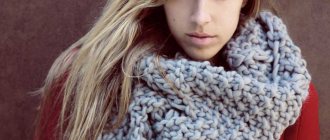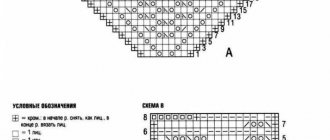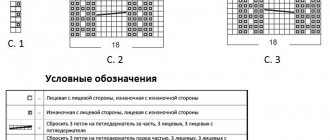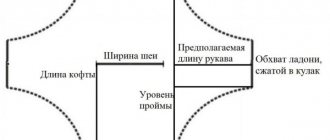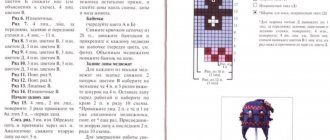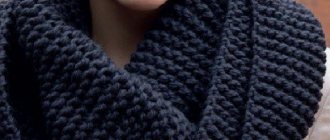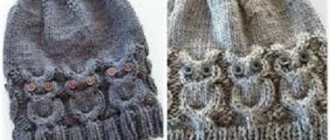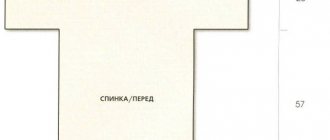Knitted leg warmers came into our everyday life from sports. They are convenient for playing football, aerobics, and yoga. Leg warmers are essential for dancing. Buying leg warmers in your size can be difficult. We suggest you knit leg warmers with knitting needles. A variety of stylistic and color solutions will allow you to choose the best option for yourself. Leg warmers can be knitted from dense threads in a simple pattern for beginner craftswomen - then they will warm your legs in frosty weather. You can knit original openwork ones, or there are models in ethno style.
Simple and warm
Let's start with the simplest model. These socks are useful for dancing and playing sports.
Their length is 40cm.
We will need:
- thick yarn of mixed composition with a predominance of wool;
- set of sock knitting needles No. 3.5-4.
Pattern used: rib 3k.x2p.
Knitting density: 22p. for 30r. correspond to a square of 10 cm by 10 cm.
Description
We dial 60p. and knit in a round 40cm. Close the loops according to the drawing.
Video lesson:
Leg warmers with cable pattern and seam
Children's leg warmers can be started at the top and knitted downwards or, conversely, started from the ankle and continued knitted upwards. You can use a circular knitting technique or knit a fabric, the edges of which are subsequently sewn together. The choice of method depends on the personal preferences of the knitter. Having cast on the loops in the Italian way, we knit a 1 x 1 elastic band and move on to knitting a pattern with embossed braids.
The upper elastic band, the loops of which are closed with a needle, is knitted at double length, which allows you to make a decorative lapel. You will need to take two measurements - the circumference of the leg under the knee and the height of the leg from the knee to the ankle.
Striped
To work you will need:
- gray yarn of mixed composition (50g per 200m) – 100g;
- dark gray yarn of mixed composition (50g per 200m) - 50g;
- set of toe knitting needles No. 2.5.
Patterns used:
- elastic band 2 knits x 2 purls;
- persons satin stitch: when knitting in the round, knit all stitches;
- openwork: knitted according to patterns A, B, C. In even rows we knit all the loops and yarn overs.
You need to repeat rapports in a row - see diagram.
Knitting density: knitting. Ch.: 30p. by 42r. correspond to a square of 10cm by 10cm, on openwork: 26p. for 42r. correspond to a 10cm by 10cm square.
Description
We dial 72p. gray threads and switch to circular knitting, distributing all the loops into 4 sp. - 18 on each. Next we knit 10 rubles. rubber bands, 1 rub. knit, 12cm openwork - pattern A (we finish with the 6th or 12th row of the pattern). Then - 5 rubles. rubber bands. Change the thread to dark gray. We knit 1 p. facial, 5 rub. rubber bands, 12cm openwork - pattern B, 5r. rubber bands. We return to gray again. We knit 1 p. with this color. facial, 5 rub. rubber bands, 1 rub. knit, 12cm openwork - pattern C (we finish with the 8th or 16th row of the pattern), 10 rubles. rubber bands. We close the loops.
Leg warmers with frills
Such beauty can be knitted for both young women and children. We simply reduce children's sizes proportionally.
To work you will need:
- gray yarn of mixed composition (50g per 130m) -200g;
- some purple threads;
- set of toe knitting needles No. 3;
- hook No. 2.5;
- additional circular knitting needles.
Description
We dial 84p. and switch to circular knitting, distributing 21 stitches. on a knitting needle. Let's knit 12 rubles. rubber bands 1l.x1p. In the next row we knit 2 stitches from each stitch. We remove each added stitch onto an additional knitting needle - we will knit frills from these loops. We continue the main knitting 3p.x1p., adding 1p. on each sleeper (i.e. we have 22 points per sp.).
Having knitted 7cm, we repeat the increase as described and remove the additional loops. sp. Having knitted 3.5cm 3L x 1P, we begin to make decreases: in every 8th p. decrease evenly in 3 stitches, knitting from 2 stitches. one front one. Having knitted another 3.5 cm, we repeat the increase on the frills and the removal of the loops on the additional one. sp. We repeat 2 more times, 7 cm each with decreases (see above), removing the item for the frills. We get 5 frills. After the 5th we knit 12 rubles. 1L x 1P and close the loops.
Frills
Let's knit in a circle of faces. satin stitch Starting from the second day. in every 3rd r. we make increases by knitting from 1p. - three. We must knit 10 rubles, three of which with increases. Distribution of additions: for the 1st and 2nd frills we make them every 3rd row, i.e. 6 increases; for the 3rd and 4th frills - in every 3rd r., i.e. 5 increases; for the 5th frill - in every 3rd r., i.e. 4 increases. We tie the edge of the frills with purple thread in single crochet stitches. To give the product its shape, it needs to be lightly steamed.
Preparing for work
For knitting, beginning needlewomen will need:
- a pair of double needles, number 2;
- shimmering black yarn “Pekhorka” - 100 g (430 m);
- size chart according to which you can knit leggings not only for girls, but also for adult women.
When describing the knitting pattern we will use the following abbreviations:
- n. - loops;
- n. – yarnover
Leg warmers in ethno style
These knitted socks for women are made with folk Tyrolean motifs. They go perfectly with high heels.
We will need:
- h/w yarn of black, milky, bronze, white, sand colors - 50g of each (50g per 100m);
- sp. No. 4;
- markers;
- needle with a large eye;
- buttons Ø 20mm – 14 pieces.
Finished dimensions: length - 53.5 cm (stretched), volume at the widest point - 35.5 cm.
Knitting density: 21p. for 28 rub. correspond to a 10cm by 10cm square. Before work, it is recommended to perform a sample according to cx. 2 – check the length.
Description
Left
We cast on 75 stitches with bronze threads and knit 32 rubles. according to cx. No. 1 with straight fabric.
Knitting the next row on the wrong side. side, mark it with a marker and close it for circular knitting. Ignore the mismatch of the pattern at the joint. A button placket will hide this flaw.
Knit faces. satin stitch 9.5 cm. Knit 5 times in cx. No. 2 20 rows of rapport, decreasing 9 times at the end of every 10 rubles. 1 p. We will have 57p left. We continue to knit 15 rubles. according to cx. No. 3 at 57p. (the first is the edge one).
Bottom cuff
Knit 4cm of elastic band 2L x 2P. Close the loops.
Button placket
On the front side, using bronze threads, starting from the bottom cuff, below the decrease line, cast on 102p. We complete the set at a height of 2.5 cm of the top drawing cx. No. 2. Having knitted 4cm strips, close the loops. Carefully sew the edges of the strip. Sew buttons at equal intervals. If you couldn’t find buttons exactly matching the color of the threads, don’t worry - you can crochet them with the necessary threads. Sew the top cuff from the inside.
Right
We will knit according to the same description, except for the strap. It is more convenient to knit it from top to bottom: that is, we start the set with 2.5 cm before the first repeat of cx. No. 2. We dial 102p. and connect according to the previous algorithm. We design the right one in the same way as the left one.
Video lesson:
How to knit leg warmers
The leg warmers are knitted in a voluminous but easy-to-make pattern. Above and below the pattern are 2 x 1 elastic bands. Five knitting needles were used for knitting. We start knitting from the top elastic band, for which we cast on 54 loops. When distributing the loops across the knitting needles, two end up with 14 loops each, and two end up with 13 loops each.
After completing the elastic band, we begin to knit a beautiful relief pattern, the construction of which is discussed in detail in the video tutorial. After the pattern, the bottom elastic band is knitted, and all that remains is to tuck the threads that remain after knitting into the knitting. The leg warmers are ready, and you can try them on and see how they look on your feet.
Knitted leg warmers made from “grass”
Cute little white knitted socks look very original and are easy to knit.
To work you will need:
- plain white mixed yarn - 100g;
- white “grass” yarn – 100g;
- set of socks No. 3.5.
Patterns used:
- elastic band 2 knits x 2 purls;
- purl satin stitch: when knitting straight - in faces. rows, all loops are purl, in purl. rows - facial ones.
Description
Cast on with a smooth thread 42p. and tie an elastic band 3cm high. We switch to “grass” threads. Having knitted 2 p. from it. satin stitch, change the thread to a smooth one and knit 4p. Alternating the threads in this way, we knit 25cm in height. Then we knit 3 cm 2l.x2i with a smooth thread. We close the loops. We carefully sew it together.
Openwork
Dimensions: length 40cm, width 27cm, elastic band diameter at the bottom 13cm.
We will need:
- acrylic yarn - about 200g;
- circular sp. No. 6;
- marker.
Knitting density: 24p. for 16r. correspond to a square 10 cm by 10 cm
Description
We start knitting leg warmers with knitting needles from the 48p cast-on. We switch to circular knitting. Place a marker at the connection point. We knit 5cm 2L x 2P.
We switch to openwork and perform 10cm according to the scheme:
1r.: *2l, 1l. for the bottom slice, 1i.* - repeat from * to * until the end of the row;
2p.:*2p.in 1p., 1n.,1l., 1p.* – repeat from * to* until the end of the row;
3R: *3L, 1P* – repeat from * to* until the end of the row;
4r.:*1l., 1n., 2l. for the bottom slice, purl 1* – repeat from * to* until the end of the row.
After this, we begin to add loops: in every 4th r. Add 1 stitch symmetrically from the marker. We do this 8 times. We end up with 64p.
We continue to perform the openwork for another 30 cm in height. Then we move on to decreases. Symmetrically from the marker in every 2nd r. decrease by 1 p. twice. 60p left. We knit a 10cm elastic band.
Making patterns
Seamless leg warmers do not require patterns. Therefore, this item is only for those who decide to make leg warmers on two knitting needles.
- A rectangle is drawn on graph paper. Its largest side is the entire length of the leggings.
- The smallest width will indicate calf girth.
- The resulting rectangle is placed lengthwise.
- The small sides are divided in two. The midpoints are connected by a line.
- To set the vertical, you need to set aside the length of the entire leggings from the top line.
- Lines are drawn parallel to the horizontal ones.
- On the top line, the half-circuits of the leg are laid at the top point of the leggings - on both sides.
- On the line at the very bottom is the ankle circumference.
- You need to connect all the ends of the lines with a smooth curved line.
- At the bottom you will need to add another small rectangle - it will play the role of a lapel.
The pattern usually doesn’t work out the first time - that’s not a problem. Over time, it will not take a little time.
With a relief braid
To work you will need:
- mixed yarn -200g;
- set of sp. No. 4.
Patterns used:
- relief: 1r.: 1kr., 3p., *2l., 6i.* – repeat from * and to * twice, braid according to the pattern, * 6i., 2l.* – repeat from * and to * twice, 3i., 1cr; 2 rub. and all even ones - according to the picture.
- elastic band 3l.x3i.
Description
Dial 74p. (72 stitches per pattern and 1 stitch on each side) and tie 8cm elastic bands. Then we move on to relief, first decreasing 1 purl at a time. p. symmetrically along the edges of the pattern. We get only 72 stitches: 34 stitches of which are for the relief pattern in the center and 18 stitches each. for elastic plus 1cr. around the edges. Having knitted 15cm, we begin to make decreases in every 20th row: 4p. - once, 2p. -1 p., 4 p. – 3 rub. The total height of the relief pattern should be 42cm. Then we move on to knitting elastic. Its height is 18cm.
We close the loops. We sew the seam from the wrong side.
Video lesson:
Leg warmers with ties
The leg warmers were knitted for a leg volume of 36 cm at the shin with a length of 32 centimeters. An elastic band is knitted at the top and bottom, the leg warmers themselves are decorated with a beautiful relief pattern, the upper part is additionally tightened with a knitted cord. For knitting, five 3-millimeter needles are used, with which the product is knitted in the round, without a single seam. Oxford threads made from 100% acrylic were used.
Knitting begins with the formation of a 2 x 2 elastic band, then a pattern is created in the form of voluminous braids. Throughout your knitting, it is advisable to keep a notebook in which you write down how many rows you knitted, so that you can then reproduce the same pattern on the second, paired item.
